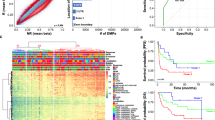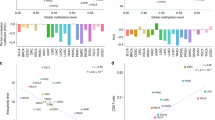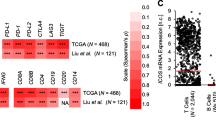Abstract
Tumor immunogenicity is driven by various genomic and transcriptomic factors but the association with the overall status of methylation aberrancy is not well established. We analyzed The Cancer Genome Atlas pan-cancer database to investigate whether the overall methylation aberrancy links to the immune evasion of tumor. We created the definitions of hypermethylation burden, hypomethylation burden and methylation burden to establish the values that represent the degree of methylation aberrancy from human methylation 450 K array data. Both hypermethylation burden and hypomethylation burden significantly correlated with global methylation level as well as methylation subtypes defined in previous literatures. Then we evaluated whether methylation burden correlates with tumor immunogenicity and found that methylation burden showed a significant negative correlation with cytolytic activity score, which represent cytotoxic T cell activity, in pan-cancer (Spearman rho = − 0.37, p < 0.001) and 30 of 33 individual cancer types. Furthermore, this correlation was independent of mutation burden and chromosomal instability in multivariate regression analysis. We validated the findings in the external cohorts and outcomes of patients who were treated with immune checkpoint inhibitors, which showed that high methylation burden group had significantly poor progression-free survival (Hazard ratio 1.74, p = 0.038). Overall, the degree of methylation aberrancy negatively correlated with tumor immunogenicity. These findings emphasize the importance of methylation aberrancy for tumors to evade immune surveillance and warrant further development of methylation biomarker.




Similar content being viewed by others
Availability of data and material
All data generated or analyzed during this study are included in this published article and its supplementary information files with an exception of clinical data of SMC cohort. The data of SMC cohort are available from the authors upon reasonable request.
References
D’Errico G, Machado HL, Sainz B (2017) A current perspective on cancer immune therapy: step-by-step approach to constructing the magic bullet. Clin Transl Med. https://doi.org/10.1186/s40169-016-0130-5
Havel JJ, Chowell D, Chan TA (2019) The evolving landscape of biomarkers for checkpoint inhibitor immunotherapy. Nat Rev Cancer 19:133–150. https://doi.org/10.1038/s41568-019-0116-x
Goodman AM, Kato S, Bazhenova L et al (2017) Tumor mutational burden as an independent predictor of response to immunotherapy in diverse cancers. Mol Cancer Ther. https://doi.org/10.1158/1535-7163.MCT-17-0386
Le DT, Uram JN, Wang H et al (2015) PD-1 blockade in tumors with mismatch-repair deficiency. N Engl J Med 372:2509–2520. https://doi.org/10.1056/NEJMoa1500596
Hellmann MD, Ciuleanu T-E, Pluzanski A et al (2018) Nivolumab plus Ipilimumab in Lung Cancer with a High Tumor Mutational Burden. N Engl J Med 378:2093–2104. https://doi.org/10.1056/NEJMoa1801946
Davoli T, Uno H, Wooten EC, Elledge SJ (2017) Tumor aneuploidy correlates with markers of immune evasion and with reduced response to immunotherapy. Science. https://doi.org/10.1126/science.aaf8399
Ock CY, Hwang JE, Keam B et al (2017) Genomic landscape associated with potential response to anti-CTLA-4 treatment in cancers. Nat Commun 8:1–12. https://doi.org/10.1038/s41467-017-01018-0
Ayers M, Lunceford J, Nebozhyn M et al (2017) IFN- γ – related mRNA profile predicts clinical response to PD-1 blockade. J Clin Invest 127:2930–2940. https://doi.org/10.1172/JCI91190
Rooney MS, Shukla SA, Wu CJ et al (2015) Molecular and genetic properties of tumors associated with local immune cytolytic activity. Cell 160:48–61. https://doi.org/10.1016/j.cell.2014.12.033
Micevic G, Theodosakis N, Bosenberg M (2017) Aberrant DNA methylation in melanoma: biomarker and therapeutic opportunities. Clin Epigenet 9:1–15. https://doi.org/10.1186/s13148-017-0332-8
Robertson KD, Jones PA (2000) DNA methylation: past, present and future directions. Carcinogenesis 21:461–467
Baylin SB (2002) Aberrant patterns of DNA methylation, chromatin formation and gene expression in cancer. Hum Mol Genet 10:687–692. https://doi.org/10.1093/hmg/10.7.687
Ehrlich M (2010) DNA hypomethylation in cancer cells. Epigenomics 1:239–259. https://doi.org/10.2217/epi.09.33.DNA
Saghafinia S, Mina M, Riggi N et al (2018) Pan-cancer landscape of aberrant dna methylation across human tumors. Cell Rep 25:1066–1080.e8. https://doi.org/10.1016/j.celrep.2018.09.082
Rosenthal R, Cadieux EL, Salgado R et al (2019) Neoantigen-directed immune escape in lung cancer evolution. Nature 567:479–485. https://doi.org/10.1038/s41586-019-1032-7
Wang H, Wang J, Ning C et al (2017) Genome-wide DNA methylation and transcriptome analyses reveal genes involved in immune responses of pig peripheral blood mononuclear cells to poly I:C. Sci Rep 7:1–11. https://doi.org/10.1038/s41598-017-10648-9
Rosenberg SA, Robins HS, Stevanović S et al (2017) Landscape of immunogenic tumor antigens in successful immunotherapy of virally induced epithelial cancer. Science 56:200–205. https://doi.org/10.1126/science.aak9510
Jung H, Kim HS, Kim JY et al (2019) DNA methylation loss promotes immune evasion of tumours with high mutation and copy number load. Nat Commun 10:1–12. https://doi.org/10.1038/s41467-019-12159-9
Network TCGAR, Weinstein JN, Collisson EA et al (2013) The Cancer Genome Atlas Pan-cancer analysis project. Nat Genet 45:1113–1120. https://doi.org/10.3779/j.issn.1009-3419.2015.04.02
Collisson EA, Campbell JD, Brooks AN et al (2014) Comprehensive molecular profiling of lung adenocarcinoma. Nature 511:543–550. https://doi.org/10.1038/nature13385
Lawrence MS, Sougnez C, Lichtenstein L et al (2015) Comprehensive genomic characterization of head and neck squamous cell carcinomas. Nature 517:576–582. https://doi.org/10.1038/nature14129
Koboldt DC, Fulton RS, McLellan MD et al (2012) Comprehensive molecular portraits of human breast tumours. Nature 490:61–70. https://doi.org/10.1038/nature11412
Liu Y, Sethi NS, Hinoue T et al (2018) Comparative molecular analysis of gastrointestinal adenocarcinomas. Cancer Cell 33:721–735.e8. https://doi.org/10.1016/j.ccell.2018.03.010
Turcan S, Rohle D, Goenka A et al (2012) IDH1 mutation is sufficient to establish the glioma hypermethylator phenotype. Nature 483:479–483. https://doi.org/10.1038/nature10866
Hansen KD (2016) IlluminaHumanMethylation450kanno.ilmn12.hg19: Annotation for Illumina’s 450k methylation arrays
Karlsson A, Jönsson M, Lauss M et al (2014) Genome-wide DNA methylation analysis of lung carcinoma reveals one neuroendocrine and four adenocarcinoma epitypes associated with patient outcome. Clin Cancer Res 20:6127–6140. https://doi.org/10.1158/1078-0432.CCR-14-1087
Sean D, Meltzer PS (2007) GEOquery: a bridge between the Gene Expression Omnibus (GEO) and BioConductor. Bioinformatics 23:1846–1847. https://doi.org/10.1093/bioinformatics/btm254
Klco JM, Spencer DH, Lamprecht TL et al (2013) Genomic impact of transient low-dose decitabine treatment on primary AMLcells. Blood 121:1633–1643. https://doi.org/10.1182/blood-2012-09-459313
Du P, Zhang X, Huang CC et al (2010) Comparison of Beta-value and M-value methods for quantifying methylation levels by microarray analysis. BMC Bioinformatics. https://doi.org/10.1186/1471-2105-11-587
Aran D, Sirota M, Butte AJ (2015) Systematic pan-cancer analysis of tumour purity. Nat Commun 6:1–11. https://doi.org/10.1038/ncomms9971
Sinha R, Larsson E, Gao J et al (2013) Integrative analysis of complex cancer genomics and clinical profiles using the BioPortal. Sci Signal 6:pl1. https://doi.org/10.1126/scisignal.2004088
Cerami E, Gao J, Dogrusoz U et al (2012) The cBio cancer genomics portal: an open platform for exploring multidimensional cancer genomics data. Cancer Discov 2:401–404. https://doi.org/10.1158/2159-8290.CD-12-0095
Krämer A, Green J, Pollard J, Tugendreich S (2014) Causal analysis approaches in ingenuity pathway analysis. Bioinformatics 30:523–530. https://doi.org/10.1093/bioinformatics/btt703
Ehrlich M (2009) DNA hypomethylation in cancer cells. Epigenomics 1:239–259. https://doi.org/10.2217/EPI.09.33
Thorsson VV, Gibbs DL, Brown SD et al (2018) The immune landscape of cancer. Immunity 48:812–830.e14. https://doi.org/10.1016/j.immuni.2018.03.023
Galon J, Angell HK, Bedognetti D, Marincola FM (2013) The continuum of cancer immunosurveillance: prognostic, predictive, and mechanistic signatures. Immunity 39:11–26. https://doi.org/10.1016/j.immuni.2013.07.008
Shen H, Shih J, Hollern DP et al (2018) Integrated molecular characterization of testicular germ cell tumors. Cell Rep 23:3392–3406. https://doi.org/10.1016/j.celrep.2018.05.039
Yuan Y, Failmezger H, Rueda OM et al (2012) Quantitative image analysis of cellular heterogeneity in breast tumors complements genomic profiling. Sci Transl Med 4:157ra143. https://doi.org/10.1126/scitranslmed.3004330
Schadendorf D, Hodi FS, Robert C et al (2015) Pooled analysis of long-term survival data from phase II and phase III trials of ipilimumab in unresectable or metastatic melanoma. J Clin Oncol 33:1889–1894. https://doi.org/10.1200/JCO.2014.56.2736
Wolchok JD, Chiarion-Sileni V, Gonzalez R et al (2017) Overall survival with combined nivolumab and ipilimumab in advanced melanoma. N Engl J Med 377:NEJMoa1709684. https://doi.org/10.1056/NEJMoa1709684
Roh W, Chen PL, Reuben A et al (2017) Integrated molecular analysis of tumor biopsies on sequential CTLA-4 and PD-1 blockade reveals markers of response and resistance. Sci Transl Med 9:1. https://doi.org/10.1126/scitranslmed.aah3560
Kim J, Orkin SH (2011) Embryonic stem cell-specific signatures in cancer: insights into genomic regulatory networks and implications for medicine. Genome Med. https://doi.org/10.1186/gm291
Martinocorena I, Fowler JC, Wabik A et al (2018) Somatic mutant clones colonize the human esophagus with age. Science 362:911–917. https://doi.org/10.1126/science.aau3879
Yizhak K, Kim J, Aguet F et al (2017) Abstract LB-231: identifying cancer-related processes in normal tissues via RNA-seq. Cancer Res 77:LB-231. https://doi.org/10.1158/1538-7445.am2017-lb-231
Roufas C, Chasiotis D, Zaravinos A et al (2018) The expression and Prognostic Impact of Immune Cytolytic Activity-Related Markers in Human Malignancies: a Comprehensive Meta-analysis. Front Oncol 8:1–18. https://doi.org/10.3389/fonc.2018.00027
Dunn J, Rao S (2017) Epigenetics and immunotherapy: the current state of play. Mol Immunol 87:227–239. https://doi.org/10.1016/j.molimm.2017.04.012
Timp W, Feinberg AP (2013) Cancer as a dysregulated epigenome allowing cellular growth advantage at the expense of the host. Nat Rev Cancer 13:497–510. https://doi.org/10.1038/nrc3486
Peng D, Kryczek I, Nagarsheth N et al (2015) Epigenetic silencing of TH1-type chemokines shapes tumour immunity and immunotherapy. Nature 527:249–253. https://doi.org/10.1038/nature15520
Zaretsky JM, Garcia-Diaz A, Shin DS et al (2016) Mutations associated with acquired resistance to PD-1 blockade in melanoma. N Engl J Med 375:819–829. https://doi.org/10.1056/NEJMoa1604958
Kuss-Duerkop SK, Pyeon D, Westrich JA (2018) DNA tumor virus regulation of host dna methylation and its implications for immune evasion and oncogenesis. Viruses 10:1–24. https://doi.org/10.3390/v10020082
Duruisseaux M, Martínez-Cardús A, Calleja-Cervantes ME et al (2018) Epigenetic prediction of response to anti-PD-1 treatment in non-small-cell lung cancer: a multicentre, retrospective analysis. Lancet Respir Med 6:771–781. https://doi.org/10.1016/S2213-2600(18)30284-4
Hunt BG, Glastad KM, Yi SV, Goodisman MAD (2013) The function of intragenic DNA methylation: insights from insect epigenomes. Integr Comp Biol 53:319–328. https://doi.org/10.1093/icb/ict003
Shenker N, Flanagan JM (2012) Intragenic DNA methylation: implications of this epigenetic mechanism for cancer research. Br J Cancer 106:248–253. https://doi.org/10.1038/bjc.2011.550
Rauscher GH, Kresovich JK, Poulin M et al (2015) Exploring DNA methylation changes in promoter, intragenic, and intergenic regions as early and late events in breast cancer formation. BMC Cancer 15:1–15. https://doi.org/10.1186/s12885-015-1777-9
McCabe MT, Brandes JC, Vertino PM (2009) Cancer DNA methylation: molecular mechanisms and clinical implications. Clin Cancer Res 15:3927–3937. https://doi.org/10.1158/1078-0432.CCR-08-2784
Acknowledgements
The results shown here are in part based upon data generated by the TCGA Research Network: https://www.cancer.gov/tcga.
Funding
This work was supported by the National Research Foundation of Korea (NRF) grant funded by the Korea government (MSIT) (NRF-2019R1C1C1004295), and the Korea Health Technology R&D Project through the Korea Health Industry Development Institute (KHIDI), funded by the Ministry of Health & Welfare, Republic of Korea (grant number: HI17C0048).
Author information
Authors and Affiliations
Contributions
Conceptualization: CYO and CP; Methodology and Software: KK, KJ, JHP and SJ; Validation and Formal Analysis, CYO, KK, CP, KJ and JHP; Funding Acquisition CYO; Supervision CYO, MK, BK, TMK, YKJ, SHL, JSL, DWK, GHK, DHC, and DSH; Visualization and Writing—Original Draft, CP and KJ; Writing—Review & Editing, Approval of Manuscript, all authors.
Corresponding authors
Ethics declarations
Conflict of interest
The authors declare that they have no competing interests.
Additional information
Publisher's Note
Springer Nature remains neutral with regard to jurisdictional claims in published maps and institutional affiliations.
Electronic supplementary material
Below is the link to the electronic supplementary material.
Rights and permissions
About this article
Cite this article
Park, C., Jeong, K., Park, JH. et al. Pan-cancer methylation analysis reveals an inverse correlation of tumor immunogenicity with methylation aberrancy. Cancer Immunol Immunother 70, 1605–1617 (2021). https://doi.org/10.1007/s00262-020-02796-1
Received:
Accepted:
Published:
Issue Date:
DOI: https://doi.org/10.1007/s00262-020-02796-1




